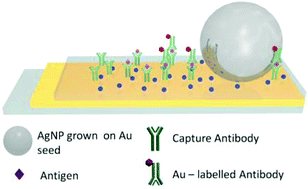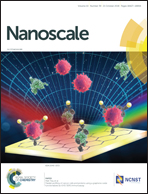In situ generation of plasmonic cavities for high sensitivity fluorophore and biomolecule detection†
Abstract
Plasmonic cavities are widely studied for the large amplifications in fluorophore emission intensity that they can achieve. Exploiting these properties for biological sensing applications requires strategies to selectively insert the target antigen into a resonant cavity, which are often of similar size or smaller than the target molecule. Here we demonstrate that using relatively simple solution processing, cavity structures can be grown at the stochastic locations where antigen binding takes place, which yields large enhancements in fluorophore emission intensities and over an order of magnitude improvement in bioassay response. The fluorescence amplification generated by the in situ growth of plasmonic structures is sufficiently large to enable both single antigen and single low-quantum efficiency fluorophore detection. The simplicity of the process demonstrated negates the requirement for complex surfaces or geometries and is readily adaptable for a wide range of diagnostic applications.



 Please wait while we load your content...
Please wait while we load your content...